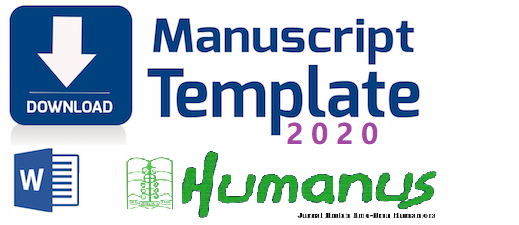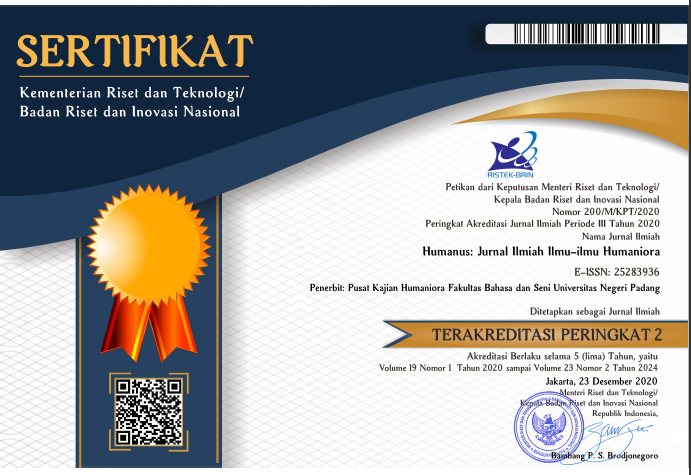Basic Colors in Javanese and Indonesian Languages: Natural Semantic Metalanguage Theory
 ),
), (1) Universitas Sumatera Utara
(2) Universitas Sumatera Utara
(3) Universitas Sumatera Utara
 Corresponding Author
Corresponding Author
Copyright (c) 2024 Dwi Kurnia Surya Ningrum, Christanta Rejuna Phanes S Brahmana, Mulyadi Mulyadi
DOI : https://doi.org/10.24036/humanus.v23i1.126103
Full Text:
 Language : en
Language : en
Abstract
Keywords
References
Abbott, J. T., Griffiths, T. L., & Regier, T. (2016). Focal colors across languages are representative members of color categories. Proceedings of the National Academy of Sciences of the United States of America, 113(40), 11178–11183. https://doi.org/10.1073/pnas.1513298113
Berlin, B., & Kay, P. (1969). Basic Color Terms: Their Universality and Evolution. The University of California Press.
Biggam, C. P. (2012). The Semantics of Colour: A Historical Approach. Cambridge University Press.
Bogdan, R. C., & Taylor, S. J. (1992). Pengantar Metode Penelitian Kualitatif, Terjemahan oleh Arief Ruchan. Usaha Nasional.
Budiono, S. (2016). Klasifikasi Warna Masyarakat Betawi di Madura, Jakarta Utara. Sirok Bastra Jurnal Ilmiah Kebahasaan Dan Kesastraan, 4(2), 101–110.
Darmaprawira, S. (2002). Warna: teori dan kreativitas penggunaannya edisi ke-2. Penerbit ITB.
Daulay, E., & Mulyadi. (2022). Color in Mandailing Language: A Semantic Study of Connotation. Lakhomi Journal Scientific Journal of Culture, 3(2), 39–48. https://doi.org/10.33258/lakhomi.v3i2.682
Fauzi, M. I., Khasanah, N., & Pavita, M. D. A. (2021). The Concept of Color Metaphor In Sundanese: A Semantic Cognitive Study. Lensa: Kajian Kebahasaan, Kesusastraan, Dan Budaya, 11(1), 33. https://doi.org/10.26714/lensa.11.1.2021.33-41
George, M. W. (2008). The Elements of Library Research. Princenton University Press.
Goddard, C. (2008). NAtural Semantic Metalanguage:The state of the art. In C. Goddard (Ed.), Cross-Linguistic Semantics (pp. 1–34). John Benjamins Publishing Company. https://doi.org/10.1075/slcs.102.05god
Hadi, S. (2004). Metodologi Research. Andi.
Jonauskaite, D., Althaus, B., Dael, N., Dan-Glauser, E., & Mohr, C. (2019). What color do you feel? Color choices are driven by mood. Color Research and Application, 44(2), 272–284. https://doi.org/10.1002/col.22327
Jonauskaite, D., Dael, N., Chèvre, L., Althaus, B., Tremea, A., Charalambides, L., & Mohr, C. (2019). Pink for Girls, Red for Boys, and Blue for Both Genders: Colour Preferences in Children and Adults. Sex Roles, 80(9–10), 630–642. https://doi.org/10.1007/s11199-018-0955-z
Jonauskaite, D., Parraga, C. A., Quiblier, M., & Mohr, C. (2020). Feeling Blue or Seeing Red? Similar Patterns of Emotion Associations With Colour Patches and Colour Terms. I-Perception, 11(1). https://doi.org/10.1177/2041669520902484
Lakens, D., Fockenberg, D. A., Lemmens, K. P. H., Ham, J., & Midden, C. J. H. (2013). Brightness differences influence the evaluation of affective pictures. Cognition and Emotion, 27(7), 1225–1246. https://doi.org/10.1080/02699931.2013.781501
Lorentz, E., Ekstrand, C., Gould, L., & Borowsky, R. (2016). Red-hot: How colour and semantic temperature processing interact in a Stroop-like paradigm. Visual Cognition, 24(2), 173–181. https://doi.org/10.1080/13506285.2016.1183742
Ma, Y., & Kuang, L. (2022). The Semantics of "Black" in Chinese, English, and German: A Colexficational Analysis. International Journal of English Linguistics, 13(1), 74. https://doi.org/10.5539/ijel.v13n1p74
Malindra, E. (2011). Pola Penamaan Warna dalam Bahasa Jawa Analisis Struktur dan Makna. Universitas Indonesia.
Müller, T. F., Winters, J., Morisseau, T., Noveck, I., & Morin, O. (2021). Colour terms: native language semantic structure and artificial language structure formation in a large-scale online smartphone application. Journal of Cognitive Psychology, 33(4), 357–378. https://doi.org/10.1080/20445911.2021.1900199
Ou, L. C., Yuan, Y., Sato, T., Lee, W. Y., Szabó, F., Sueeprasan, S., & Huertas, R. (2018). Universal models of colour emotion and colour harmony. Color Research and Application, 43(5), 736–748. https://doi.org/10.1002/col.22243
Pansat, Z., & Khalikova, N. (2023). Semantic Features of Color in Emotional, Expressive Words: The Concept of "Blue" in the Kazakh Language. International Journal of Society, Culture and Language, 11(2), 85–93. https://doi.org/10.22034/ijscl.2023.556420.2676
Specker, E., Leder, H., Rosenberg, R., Hegelmaier, L. M., Brinkmann, H., Mikuni, J., & Kawabata, H. (2018). The universal and automatic association between brightness and positivity. Acta Psychologica, 186(April), 47–53. https://doi.org/10.1016/j.actpsy.2018.04.007
Vejdemo, S., Levisen, C., van Scherpenberg, C., Gudmundsdóttir Beck, tórhalla, Næss, Å., Zimmermann, M., Stockall, L., & Whelpton, M. (2015). Two kinds of pink: Development and difference in germanic colour semantics. Language Sciences, 49(March 2016), 19–34. https://doi.org/10.1016/j.langsci.2014.07.007
Wardana, M. K., & Mulyadi, M. (2022). How Indonesian sees the colors: Natural semantic metalanguage theory. JOALL (Journal of Applied Linguistics and Literature), 7(2), 378–394. https://doi.org/10.33369/joall.v7i2.21035
Wierzbicka, A. (1990). The meaning of color terms: Semantics, culture, and cognition. Cognitive Linguistics, 1(1), 99–150. https://doi.org/10.1515/cogl.1990.1.1.99
Wierzbicka, A. (1996). Semantics: Primes and Universals. Oxford University Press.
Wierzbicka, A. (2006). The semantics of colour: A new paradigm. In C. P. Biggam & C. J. Kay (Eds.), Progress in Colour Studies: Volume I. Language and culture (Vol. 1, Issue December, pp. 1–24). John Benjamins Publishing Company. https://doi.org/10.1075/z.pics1
Wierzbicka, A. (2008). Why there are no "colour universals" in language and thought. Journal of the Royal Anthropological Institute, 14(2), 407–425. https://doi.org/10.1111/j.1467-9655.2008.00509.x
Witzel, C. (2019). Misconceptions About Colour Categories. In Review of Philosophy and Psychology (Vol. 10, Issue 3). Review of Philosophy and Psychology. https://doi.org/10.1007/s13164-018-0404-5
Yulianti, S. (2016). Kosakata Warna Bahasa Sunda (Pendekatan Metabahasa Semantik Alami). Ranah: Jurnal Kajian Bahasa, 5(1), 76. https://doi.org/10.26499/rnh.v5i1.39
 Article Metrics
Article Metrics
 Abstract Views : 209 times
Abstract Views : 209 times
 PDF Downloaded : 72 times
PDF Downloaded : 72 times
Refbacks
- There are currently no refbacks.
Copyright (c) 2024 Dwi Kurnia Surya Ningrum, Christanta Rejuna Phanes S Brahmana, Mulyadi Mulyadi

This work is licensed under a Creative Commons Attribution-NonCommercial 4.0 International License.










